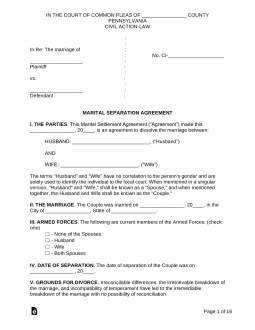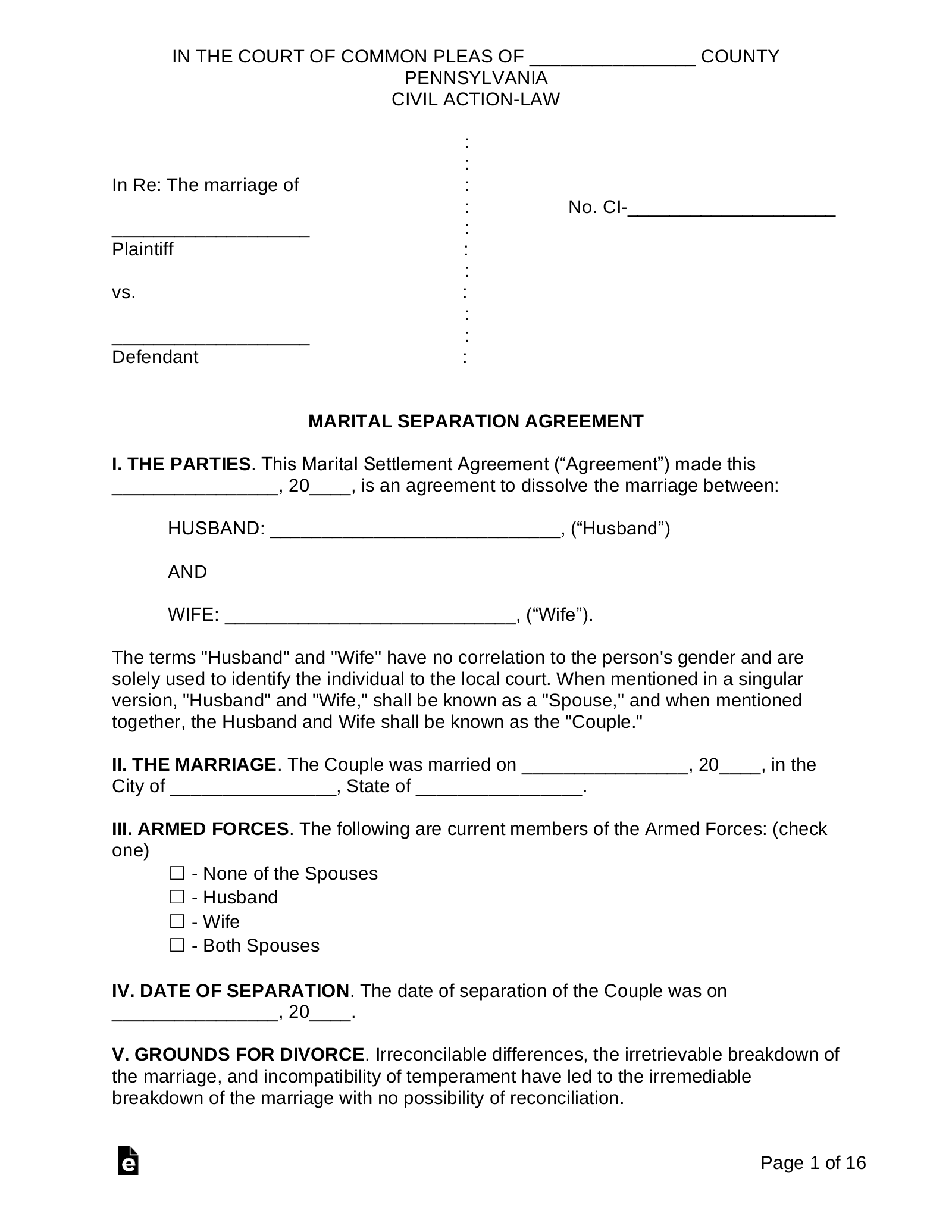Updated August 29, 2023
A Pennsylvania marital settlement agreement is a divorce tool that helps married couples settle on fair terms regarding the dissolution of their marriage. A settlement agreement is not a mandatory document in all divorce cases; however, if the parties are divorcing by mutual consent (i.e., an uncontested, no-fault divorce), a marital settlement agreement is required in most Pennsylvania counties. The provisions contained in this agreement include alimony, property distribution, child support, child custody, and other matters relevant to the spouses’ individual rights and responsibilities. It is common for the parties to seek mediation, or individual attorneys, in order to maintain civility and efficiency, and to ensure the agreement is beneficial to all parties, including any children of the marriage.
Table of Contents |
Divorce Laws
Statutes – Title 23: Chapter 33, Chapter 35, and Chapter 37
Alimony (§ 3701) – If the court deems it necessary, the court may award either party alimony in consideration of any of the following factors:
- Relative earnings and earning capacities of the parties
- Age and physical, mental, and emotional condition of the parties
- Sources of income of both parties
- Expectancies and inheritances of the parties
- Duration of the marriage
- Contribution by one party to the education, training, or increased earning power of the other party
- Extent to which the earning power, expenses, or financial obligations of a party will be affected by serving as the custodian of a minor child
- Standard of living established during the marriage
- Relative education of the parties and time necessary to acquire education to enable party seeking alimony to find employment
- Relative assets and liabilities of the parties
- Property brought to the marriage by either party
- Contribution of a spouse as a homemaker
- Relative needs of the parties
- Marital misconduct
- Tax ramifications of the alimony award
- Whether party seeking alimony lacks sufficient property
- Whether the party seeking alimony is incapable of self-support
Alimony Calculator – calculators.law
Child Support (§ 4322(a)) – A statewide child support guideline has been developed to determine the amount of support a child will receive from the obligor by calculating the net incomes and earning capacities of the parties. A child support schedule has been created and set forth in Rule 1910.16-3 of the Pennsylvania Code.
Child Support Calculator – Pennsylvania Department of Human Services
Division of Property (§ 3502(a)) – If either party to a divorce action requests that the property be divided by the courts, the court shall divide all marital property equitably between the parties after considering all relevant factors.
Grounds for Divorce (§ 3301) – Divorce may be ordered by the court on any of the following grounds:
No-Fault Divorce:
- Insanity or mental disorder leaving one spouse confined to a mental institution for at least eighteen (18) months
- Mutual consent that marriage is irretrievably broken
- One spouse believes marriage is irretrievably broken and files an affidavit affirming that the spouses have lived separately for two (2) years
Fault Divorce:
- Desertion of one spouse from the home without reason for at least one (1) year
- Adultery
- Cruel treatment or endangerment
- Bigamy
- Intolerable living conditions
Interim Support (§ 3702) – During an action for divorce, the court may award either party alimony pendente lite (during litigation) as well as any reasonable counsel fees and expenses.
Residency (§ 3104(b)) – At least one of the spouses must be a resident of Pennsylvania for at least six (6) months prior to filing a divorce action.
Separation (§ 3301(d)(1)) – Separation before divorce is only a requirement if the spouses are seeking a dissolution of their marriage on the grounds of an irretrievable breakdown. In this case, the spouses must have lived separate and apart for at least one (1) year prior to filing for divorce.
Divorce Forms
Where to File – Court of Common Pleas – Prothonotary Office
Filing Fee – Varies greatly by county (examples: $125.75 in Warren County, $300 in Montgomery County)
How Long Does it Take? Three (3) to six (6) months
- Self Represented Party Entry of Appearance
- Notice to Defend and Divorce Complaint
- Praecipe to Reinstate the Complaint
- Affidavit of Service
- Affidavit of Consent
- Waiver of Notice
- Notice of Intention to File Praecipe to Transmit Record
- Final Praecipe to Transmit Record
- Divorce Decree
- Notice to Intention to Resume Prior Surname
How to File for Divorce in Pennsylvania (8 steps)
- Marital Settlement Agreement
- Residency Requirements
- File Complaint
- Service
- Affidavit of Consent
- Praecipe to Transmit Record
- Divorce Decree
- Name Change
1. Marital Settlement Agreement

To file for a mutual consent or uncontested, no-fault divorce (or “simple” divorce), both spouses must either have no dependent children or mutually agree on child support and custody matters. Furthermore, the parties may wish to draft a Marital Settlement Agreement so they can establish all the important divorce issues on paper. This document covers divorce issues such as alimony, property division, and child support and custody. If none of these issues are applicable to the spouses’ situation, a marital agreement need not be completed. However, in all other situations, a marital settlement agreement must be established before filing a divorce action as the agreement must be filed at the same time as the divorce complaint form.
2. Residency Requirements

In addition to the requirements for filing an uncontested divorce mentioned in Step 1, at least one of the spouses must be a resident of Pennsylvania six (6) months prior to filing a complaint for divorce. Furthermore, the action must be filed in the correct county or the court may have the complaint thrown out. The spouse that is filing the complaint (they will be referred to as the plaintiff; the other spouse is the defendant) is given the following options for choosing the county in which to file:
- The county in which the defendant currently resides.
- The county in which the plaintiff resides, as long as the defendant lives outside of the state.
- The county in which the spouses lived while married, as long as the plaintiff has continuously lived there.
- If the spouses have been separated for less than six (6) months, and the defendant agrees to it, the plaintiff may file in the county in which they live.
- If the spouses have been separated for more than six (6) months, the plaintiff may file in the county in which either spouse lives.
3. File Complaint
Note: If either spouse intends on resuming their name prior to marriage, they may file a Notice of Intention to Resume Prior Surname (requires notarization). This form can be filed after filing the Complaint or after filing the Divorce Decree (Step 8).
4. Service
- Acceptance of Service – The plaintiff hands the documents to the defendant who accepts service by signing an Affidavit of Acceptance of Service (Form 3a) immediately after being served the paperwork.
- Service by Mail – The plaintiff mails the documents to the defendant by regular and certified mail with return receipt requested and then completes the Affidavit of Service by Mail (Form 3b). If the return receipt is not signed by the defendant, the plaintiff must use another service method.
- Personal Service – The plaintiff hires an eligible individual (sheriff/deputy, process server, or reliable third party) to hand the documents to the defendant. The individual must complete the Affidavit of Personal Service (Form 3c).
Whichever method is chosen, the plaintiff will have to make a copy of the appropriate affidavit form and file the original with the court.
5. Affidavit of Consent
6. Praecipe to Transmit Record
7. Divorce Decree
8. Name Change

Either spouse has the legal right to revert to their maiden name, and they may do so by filing a Notice of Intention to Resume Prior Surname. If this form was not filed after the Complaint, the party wishing to change their name may file the Notice of Intention after the Divorce Decree has been granted. This form requires notarization in order for it to be legally valid.


